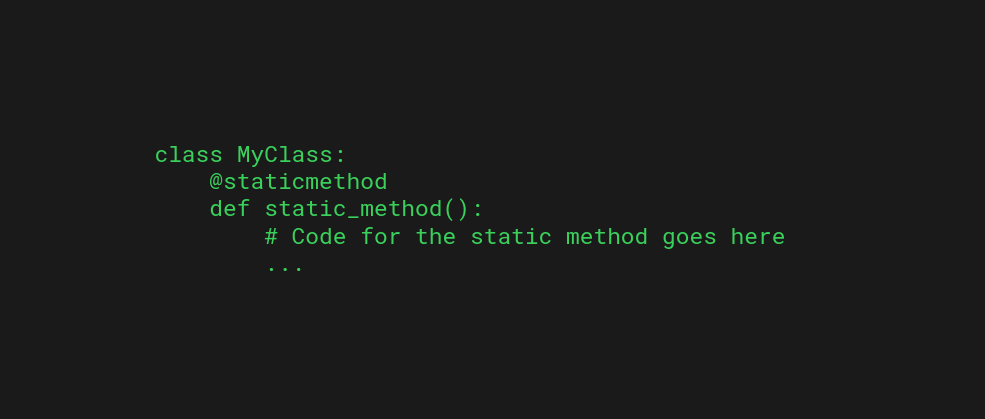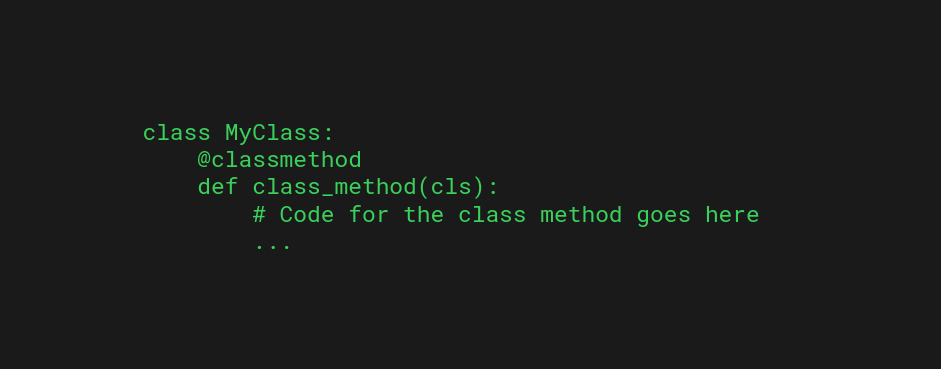In Python, the difference between the @staticmethod and @classmethod is that:
@staticmethodis usually a helper method that behaves the same way no matter what instance you call it on. The@staticmethodknows nothing about the class or its instances.@classmethodis a method that takes the class as an argument. You can use it as an alternative constructor to the class. (E.g.MyClass.from_string())
This is a complete guide to understanding the differences between @staticmethod and @classmethod in Python. You will learn when to use and when not to use these methods. All the theory is backed up with illustrative examples.
What Is a @staticmethod in Python?

In Python, a @staticmethod
This means that a @staticmethod
Here is an example of a class that defines a static method:
class MyClass:
@staticmethod
def static_method():
# Code for the static method goes here
...
To call a static method, you would do the following:
MyClass.static_method()
Note that you do not need to create an instance of the class in order to call the static method. This is because the static method belongs to the class itself, rather than to individual instances of the class. You can also see this by looking at the static method’s arguments. It takes neither self nor cls as the first argument.
What Is a @classmethod in Python?

In Python, a @classmethodcls) as the first argument, instead of an instance of the class (self).
Here is an example of a class that defines a class method:
class MyClass:
@classmethod
def class_method(cls):
# Code for the class method goes here
...
To call a class method, you would do the following:
MyClass.class_method()
Note that you do not need to create an instance of the class in order to call the class method. This is because the class method belongs to the class itself, rather than to individual instances of the class.
Also note that the first argument to the class method is the class itself, which is passed in automatically. In the example above, this argument is named cls, but it could be named anything else.
@staticmethod vs @classmethod in Python

In Python, a @staticmethod@staticmethod
On the other hand, a @classmethod is a method that is called on a class, rather than on an instance of the class. It takes the class as the first argument, rather than an instance of it. This behavior is useful if you want to create an alternative constructor method that initializes the class objects from different parameters.
For example, the dict.fromkeys() method is a class method that initializes a dictionary from keys.
Now that you understand the main difference between the class methods and static methods, let’s take a look at why and when you should use these method types.
Why Use @staticmethod?
There are several reasons why you might want to use a @staticmethod
- A
@staticmethodprovides a clear indication that the method belongs to the class, rather than to individual instances of the class. This can make the code easier to read and understand since the purpose and behavior of the method are more clearly defined. - A
@staticmethod@staticmethod - A
@staticmethod@staticmethod, which can be useful in certain scenarios.
Overall, using a @staticmethod
When Use @staticmethod in Python?
Use a @staticmethod in Python when you have a method that belongs to a class, rather than to individual instances of the class.
A @staticmethod@staticmethod
Notice that if you have a function that does not belong to a class, and that does not depend on any class-specific state, just define a regular function outside of the class. A regular function is more flexible and can be called from anywhere, without being tied to classes so unless the behavior is related to a class it’s better to leave it out of the class.
Python @classmethod as an Alternative Constructor
In Python, a classmethod can be used as an alternative constructor for a class. This means that you can use a classmethod to define a method that can be used to create and return instances of the class, in addition to the regular __init__ method that is used as the default constructor.
Here is an example of how you might use a @classmethod as an alternative constructor for a class:
class MyClass:
def __init__(self, param1, param2):
# Code for the regular constructor goes here
...
@classmethod
def from_string(cls, string):
# Code for the classmethod constructor goes here
...
In the example above, the __init__ method is the regular constructor for the MyClass class, which is called when you create an instance of the class using the MyClass() syntax.
The from_string method is a @classmethodMyClass object from a string, you can call the from_string method instead of the default initializer.
To use the from_string method as an alternative constructor, you can simply do the following:
my_object = MyClass.from_string('some string')
In this example, the from_string method is called on the MyClass class, rather than on an instance of the class. It is passed the string 'some string' as the argument, and it returns an instance of the MyClass class, which is then assigned to the my_object variable.
Overall, using a @classmethod
Summary
In Python, a class method is a method that belongs to a class rather than a particular object. It is marked with the @classmethod decorator. A class method receives the class as an implicit first argument, just like an instance method receives the instance.
A static method is a method that belongs to a class rather than a particular object. It is marked with the @staticmethod decorator. A static method does not receive any additional arguments; it behaves like a regular function but belongs to the class.
Here is an example of how to use these decorators in a Python class:
class MyClass:
@classmethod
def class_method(cls):
# ...
@staticmethod
def static_method():
# ...
The key difference between a class method and a static method is that a class method can access or modify the class state, while a static method cannot.
Thanks for reading. Happy coding!